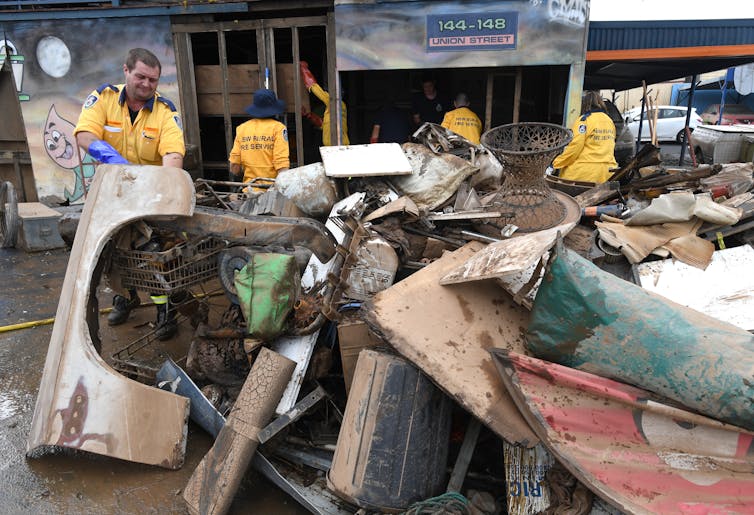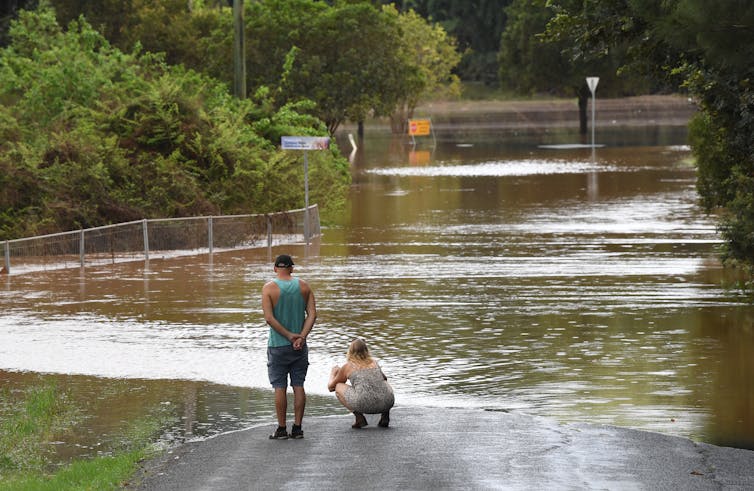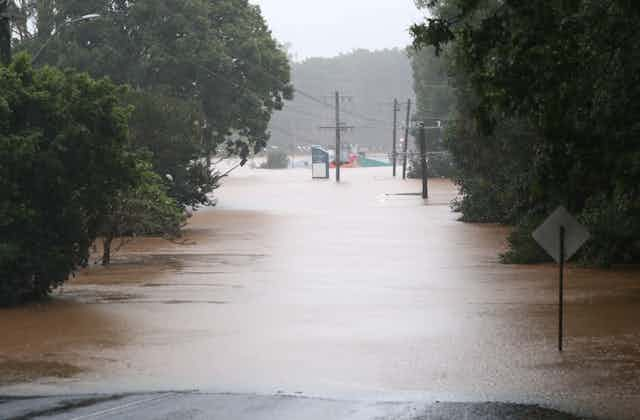Right now, Lismore residents are going through their second major flood in a month.
On February 28th, the devastating first flood peaked at 14.4 metres, fully two metres higher than the previous record of 12.27 metres in 1954, and well above the town’s 10-metre-high levee wall, constructed in 2005. Four people died, with 2000 homes destroyed or unlivable of the city’s 19,000.
Even as Lismore and Northern Rivers residents struggle to recover from the first flood, the floods are coming again. On March 29th, more heavy rain began falling onto the soaked catchment feeding into Wilsons River.
Once again, Lismore’s traumatised community had to evacuate, with predictions of floods of 10.6 metres. The flood only reached 9.7 metres. But then a further 279mm of rain fell between 9am Tuesday and 6am Wednesday 30 March, with an 11 metre flood predicted. Once again, residents had to evacuate.
Is this unprecedented? While the height of the first flood is a new record, back to back floods have happened before. Brisbane suffered three of the largest floods then recorded in rapid succession, back in 1893. Floods can come in clusters.
As the world warms, the atmosphere can hold more water. That means we are more likely to see larger floods. It is time to consider relocating flood-prone towns.
We’ve seen clusters of floods before
Lismore is no stranger to floods. The town was built on the meeting place of Wilsons River and Leycester Creek. Lismore’s deep bowl shape has seen the town nicknamed “The Wok”. As many as 30,000 people live on low-lying land at risk of flood.
The last major flood in Lismore took place in 2017, reaching 11.59 metres. Only five years later came these devastating floods. That’s an unusually small gap, and many locals were shocked at the small intermission between major floods. Then the second one hit, with almost no break between inundations.

While it is unusual, clusters of floods have happened before. In a scenario eerily familiar to the people of Lismore, Brisbane experienced three floods in a month. What’s more, two of these were the largest on record.
On February 5th 1893, Brisbane experienced a flood of 8.35 metres. It was the second highest recorded flood since 1841. Bridges, railway lines, businesses and whole streets of houses were destroyed. Roads became canals as the city lay submerged under water. Houses and shops were left coated in foul-smelling mud. There was very little time to recover as the city flooded again on February 11th, though only to 2.4 metres.
Just four days later, as the recovery was beginning again, a major new flood swept through the city. Newspapers reported the damage in this 8.09 metre flood was much less than the first, as much of the possible damage had already been done. This was not quite true as many buildings had been significantly weakened from the first inundation. The sodden land and roads were more prone to landslides and collapse.
These floods killed 35 people, and left hundreds of people homeless and unemployed. The back to back floods took a psychological toll, with newspapers reporting people were feeling despair and wretchedness. Many in Brisbane in 1893 would have been able to identify with the feeling Lismore Mayor Steve Krieg recently described as “flood fatigue”.
Read more: 'I simply haven’t got it in me to do it again': imagining a new heart for flood-stricken Lismore
Why does Australia suffer from flood clusters?
Australia has highly variable rainfall. That’s because of the well-known El Niño–Southern Oscillation, a natural climate phenomenon able to make Australia drier or wetter. In El Niño years, rainfall is significantly reduced, leaving us more vulnerable to drought. But in La Niña years, wet weather sets in, making floods more likely.
Both 1893 and 2022 are La Niña years. We’re seeing the result of wet summers saturating our river catchments and soils, leaving them less able to absorb heavy rains and more prone to flooding.
In La Niña years, large floods are more likely to come in clusters with dry periods in between. We can see this clearly in Lismore’s history.
Between 1887 and 1893, the town experienced three major floods, ranging between 10.43 and 12.46 metres.
Between 1962 and 1965, the town endured three more floods over 10 metres.
And in 1967, Lismore flooded five times between March and June, with floods ranging from 5.09 to 10.27 metres.

While La Niña years often come in pairs, the Bureau of Meteorology has warned it is possible to have three consecutive La Niña years, as we’ve seen in 1954-57, 1973-1976 and 1998-2001. All of these caused flooding in Lismore. Thankfully, at this stage it’s considered unlikely that our two years of La Niña will stretch to three.
So what can we learn?
As the world warms, floods are becoming increasing hard to predict. While dams and levee banks can reduce flood damage, they work best in minor and moderate floods. In catastrophic events such as the February flood, there is little they can do.
While La Niña years and soaked catchments make floods more likely, they do not guarantee a flood occurring.
Scientists have repeatedly warned us climate change can both dry out soils and intensify rainfall depending on the area. That means smaller floods may become less common, but floods that do occur are likely to be more frequent and more intense.
As I write, flood records in some parts of northern NSW are tumbling again. The floodwaters at Ballina, Bellingen and Lennox Head are metres above previous heights.
While it may not result in another catastrophic flood in Lismore, this will not be the town’s last flood. In fact, the record may be surpassed. It is time to discuss relocating the town away from the floodplain.
Read more: Want to help people affected by floods? Here's what to do – and what not to

